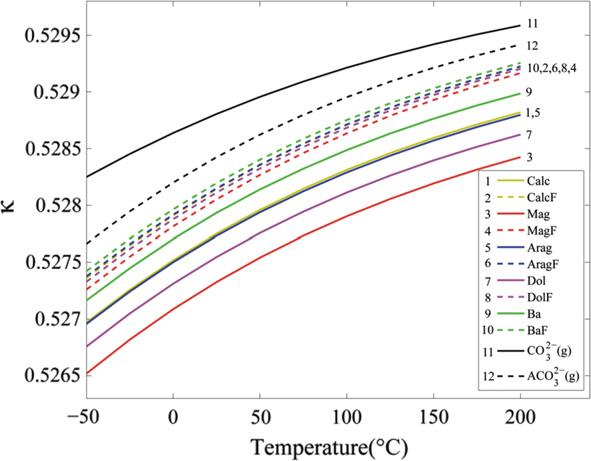With the development of analytical techniques, small O-17 anomalies can be detected precisely. Professor Boaz Luz of the Hebrew University of Jerusalem has been working in this field since 1990s. He found that such small anomaly was related to environmental changes such as biosphere productivity and oceanic humidity, which earned him the 2009 C.C. Patterson Medal.
More and more researchers have recognized that different reaction pathways have a little different mass dependent fractionation relationships (i.e. θ). Small O-17 anomalies just arise from such little difference. In other words, measurements of those small deviations are heavily dependent on the precise θ values. Although experiments can determine the precise θ values, they are very difficult due to the tough requirements on well-defined process or a set of processes in addition to high-precision analytical capabilities. That is why only a few precise θ values have been determined by experiments so far. The lack of precise θ values has become a limiting factor in further expansion of the small O-17 deviation study in many other systems. A sound theoretical framework for predicting process-specific θ values becomes necessary.
Doctoral candidate CAO Xiaobin and his advisor Professor LIU Yun, both from the State Key Laboratory of Ore Deposit Geochemistry (SKLODG) at Institute of Geochemistry, CAS (IGCAS), have solved the problem. Their work is funded by Chinese NSF projects and published on Geochimica et Cosmochimica Acta (Cao and Liu, 2011, Equilibrium mass-dependent fractionation relationships for triple oxygen isotopes. Geochimica et Cosmochimica Acta 75, 7435-7445).
In their paper, a new concept “κ” is defined. Each material has its own κ value. θ value could be calculated from κ and β values of O-18, and the latter can be found in previous theoretical or experimental works. In this way, a large number of θ values can be documented easily. They have found that the differences in κ values among materials possessing similar O-bearing group are very small, such as carbonates and silicates (See Figure below). This implies that a mean κ value can be used to estimate κ value unknown but having similar chemical group. Hence, the calculation and estimation of θ value would become easier. In the paper, κ values for most O-bearing compounds are provided, the characteristics of κ are discussed, and equilibrium θ values for CO2(g)–water, quartz–water, and calcite–water equilibrium isotope exchange reactions are also presented.
CAO and LIU’s new method offers equilibrium θ values with the precision to the third decimal number (i.e. 0.5xx) and should satisfy most of the studies on small O-17 deviation.
 |
| Fig. The comparison of κ values of carbonates calculated by different methods. Calc, Mag, Arag, Dol and Ba (solid lines) stand for κ values calculated by the Einstein-Debye model of calcite, magnesite, aragonite, dolomite and witherite, respectively. CalcF, MagF, AragF, DolF and BaF (dash lines) stand for the κ values obtained by using only internal vibration frequencies of carbonate-ion in corresponding minerals. CO32-(g) and ACO32-(g) stand for the results calculated by cluster-model method for free carbonate-ion gases. Except for CO32-(g), all the other cases are using the rule of geometric mean to obtain b values because all their oxygen atoms are exchanged during the calculation. The results of RGM are only used to explore general trends of these carbonates and they will not be used to estimate absolute θ values. |
(By CAO Xiaobin)